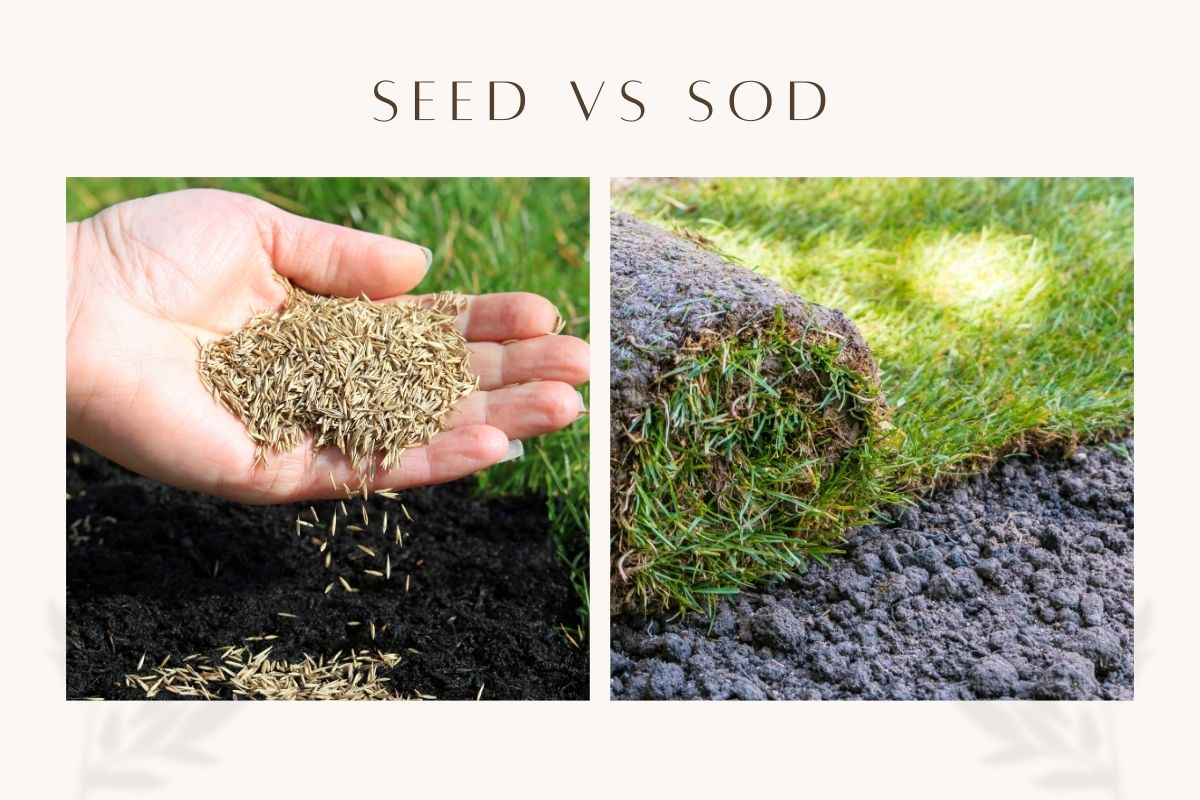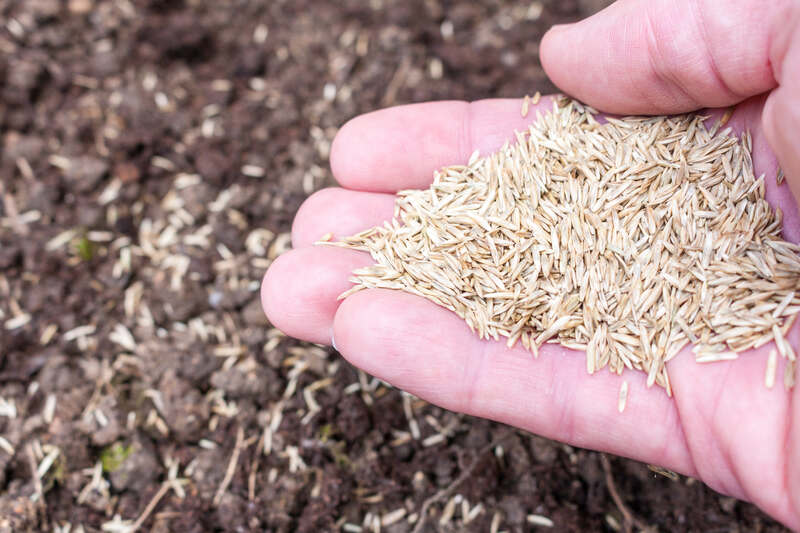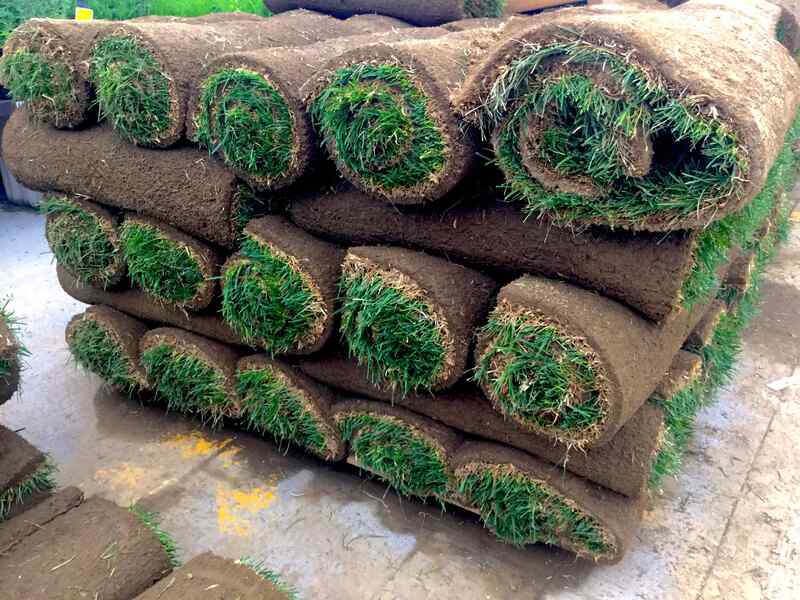
The decision between seed vs. sod choice can be tricky. On one hand, seeding requires a bit of patience but is easier on the wallet. However, sodding gives you an instant gratification but fewer choices.
Seeding involves planting grass seeds directly into the soil, allowing them to germinate and grow over time. It offers a wider selection of grass types and is more affordable, but it takes longer to establish. Meanwhile, sodding is the process of laying down pre-grown grass rolls for an instantly green lawn. While it provides immediate results, it comes at a higher cost and requires careful installation.
This guide will explain everything you need to know about each method and offer expert tips to help you choose the best option to achieve a beautiful, lush lawn.
Seed vs Sod: Factors to Consider
Before choosing between seed vs. sod, it’s important to consider your budget, how quickly you want results, maintenance, and the current condition of your yard.
If you’re starting from scratch, have the budget, and want fast results, sodding is the way to go. But if you only need to fill in patches or want to customize grass varieties for different areas, seeding is a better fit. I’ll break down these factors to help you make the best choice.
Budget
Your budget is one of the biggest factors when deciding between seed vs. sod. Spreading grass seed is the more affordable option, with costs as low as $35 depending on the area you need to cover. It’s a great DIY project, which also saves you money.
Sodding, on the other hand, comes with a higher price tag. Sod installation has an average cost of $860 to $1,750 per 1,000 square feet. While it’s a bigger investment, sod provides an instant lawn. For best results, I suggest hiring a local lawn care professional to ensure proper installation.
Time Considerations
How quickly you want a lush lawn plays a big factor between seed vs. sod. If you want an instant lawn, sod is your choice. As soon as it’s installed, your yard will look complete. However, it’s important to note that the roots need two weeks to establish. That means you can’t use it instantly but can gradually increase foot traffic after that two-week period.
In contrast, seeding requires more patience. It can take up to four weeks for your new grass seedlings to develop strong enough roots before your first mow. This means your grass also needs to be at least 3 inches tall.
“It takes nearly a full season to achieve a mature and durable lawn,” explains the University of Minnesota Extension.
Read More:
- How to Care for New Sod (5 Tips)
- Should You Put Straw Over Grass Seed?
- How Often to Water Grass Seed
Yard Size and Condition
Before deciding between seed vs. sod, take a close look at your yard’s condition. No matter which option you choose, a healthy lawn starts with healthy soil. I recommend you to do a soil test first. If your soil’s pH is off or it lacks nutrients, neither seed nor sod will thrive. Ideally, your soil should have a pH between 6.0 and 7.0. If needed, improve your soil with amendments before proceeding.
If your lawn is overrun with weeds, sod is a good choice because it creates a dense, established lawn that naturally suppresses weed growth. However, seed struggles to compete with weeds. If you plan to seed, it’s important to treat weeds first to set your new grass seedlings up for success.
The size of your yard and the level of damage also play a role. If you have a few thin patches or bare spots, seeding is the better choice because it blends well with your existing grass. If more than half of your lawn is damaged, sod is the better option. When installed correctly, it can provide an instant, uniform look and quickly cover large areas.
Read More:
Maintenance
Sod is easier to maintain once established, but it still requires careful attention in the beginning. Water generously right after installation, then continue watering regularly for the first couple of weeks to help the roots take hold.
For optimal growth of newly planted grass seed, consistent and careful maintenance is essential in the first few weeks. Keep the soil consistently moist but not waterlogged by watering lightly 2-3 times per day, adjusting the frequency based on weather conditions and soil drainage.
Once established, gradually reduce watering frequency while increasing the duration of each watering session to encourage deep root growth.
My Tip: It’s equally important to stay off the seeded area completely. If necessary, put up signs and think about temporarily blocking access with string or stakes to prevent foot traffic from disturbing your delicate seedlings.
Seed Your Lawn

Seeding allows you to choose the best grass for your yard. For example, Kentucky Bluegrass grows well in sunny areas with lots of traffic, while Fine Fescue is better for shady spots.
Timing is also essential for grass seed. The best time to seed is late summer to early fall when the soil is warm, but the air is cool, which is perfect for seed germination.
When you’re ready to spread your grass seed, I suggest clearing the area of debris and loosening the top 1 to 2 inches of soil with a rake. This helps the seed settle in and grow strong. After spreading your seeds, rake them into the soil and cover them with a thin layer of topsoil or compost.
| Advantages of Seed | Disadvantages of Seed |
| ✓ Seeding is an affordable DIY project that costs less than sod, with prices starting as low as $35 depending on the area you need to cover. | ✗ Seeds take about four weeks to grow 3 inches tall. Once they reach this height, you can mow for the first time. |
| ✓ Grass grown from seed develops strong, deep roots as it adapts to your soil from the beginning. This results in better drought resistance and a healthier lawn. | ✗ Seeds require more maintenance, including frequent watering in the beginning. |
| ✓ There are numerous seed varieties available to suit different yard needs, such as shady areas or high-traffic zones. Popular options include Kentucky Bluegrass for durability, Fine Fescue for shade tolerance, and Perennial Ryegrass for quick germination. | ✗ Weather plays a big role in seeding success. Heavy rain or strong winds can wash away seeds, while sudden dry conditions can halt germination. |
| ✓ Seeds are versatile. They can be used to thicken an existing lawn or patch up bare spots. | ✗ Birds, weeds, and erosion can disrupt growth on newly seeded lawns. Using straw or seed blankets can help protect the seeds. |
| ✓ Seeded lawns tend to be more resilient over time, adapting to local conditions and recovering more easily from damage and environmental stress. | ✗ The seeded area cannot be used until the grass is fully established. |
Read more about grass seed:
Sod Your Lawn

Successful sod installation — generally best in early spring and early fall — starts with proper ground preparation. This means removing old vegetation, grading your soil for a level surface, and ensuring your soil is healthy enough for the new grass.
Once your new sod is delivered, you don’t have much time to install it. “Ideally, fresh sod should have been cut no more than 24 hours prior to delivery,” explains the University of Minnesota Extension. “It should be laid as soon as possible, or within one day after delivery.”
Sodding is not a simple DIY project. It also requires the right tools and experience to do it properly. If you’ve never installed sod, it’s a good idea to hire a local lawn care professional to ensure it’s done correctly.
After installation, sod needs consistent moisture to establish strong roots, this means watering multiple times a day during the first two weeks.
| Advantages of Sod | Disadvantages of Sod |
| ✓ Provides a complete, mature lawn immediately after installation, perfect for homeowners who don’t want to wait weeks or months for results. | ✗ Installing sod costs an average of $860 to $1,750 per 1,000 square feet. |
| ✓ Within two weeks, your sod will establish itself. | ✗ There are fewer options available compared to seeding, as you’re restricted to what local sod farms produce in your area. |
| ✓ Instantly resistant to erosion, making it ideal for slopes or areas that need quick stabilization. | ✗ Transportation and installation can be labor-intensive and challenging, often requiring special equipment and multiple helpers if attempting DIY. |
| ✓ Sod is effective in controlling weeds and preventing erosion. | ✗ Can develop visible seam lines if not installed properly, potentially affecting the overall appearance of your lawn. |
| ✓ Can be installed during most of the growing season. | ✗ Initial root systems are typically shallower than seeded lawns, which may lead to reduced drought tolerance in the first season. |
Read more about sod:
- The Best Types of Sod for Your Lawn
- How to Lay Sod: A Step-by-Step Guide
- The 6 Best Sod Cutters of 2025 [Reviews]
FAQ About Seeding and Sodding
Dormant seeding is a lawn care technique in which grass seeds are planted when the ground is cold enough to prevent germination but not frozen. This concept is effective because sowing seeds during the dormant season prepares the lawn to sprout as soon as the soil warms up.
Read More: Check out our guide on dormant seeding for an in-depth look at the process.
A sod cutter removes the grass along with a thin layer of soil underneath. This ensures that when you lay the new sod, it will be flat and level with the rest of your lawn.
Read More: Learn everything you need to know in our guide: How to Use a Sod Cutter.
The best sods for erosion control are deep-rooted species such as tall fescue or Bermudagrass.
Read More: How to Control Erosion in the Yard
Find a Lawn Care Pro Near You
When battling the decision of seed vs. sod, remember that there’s no magic solution for a perfect lawn. I recommend sod if you want instant results, but you will probably need to hire a pro. If you don’t mind doing the work yourself, go with seed. It offers instant cost savings but months of maintenance to ensure a lush, green lawn.
For help with your seed or sod, LawnStarter can connect you with a local lawn care professional. With their expertise, your dream lawn will be well within reach.
Main Photo Credit: Seed: dean / Adobe Stock Free / License, Sod: makasana photo / Adobe Stock Free / License, Created using Canva Pro.